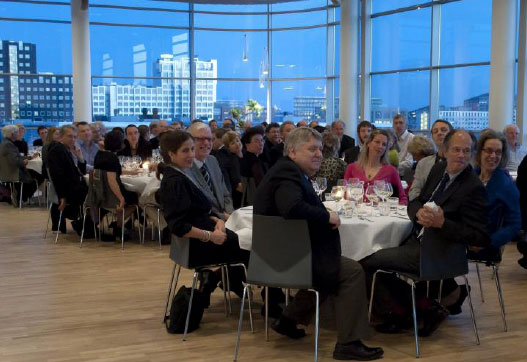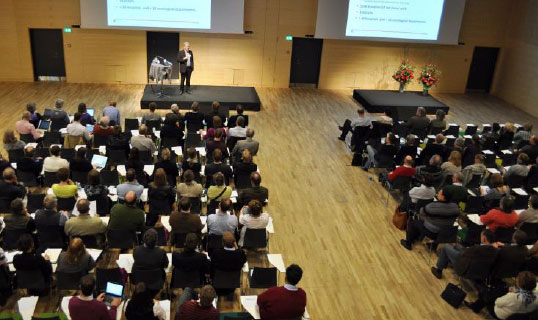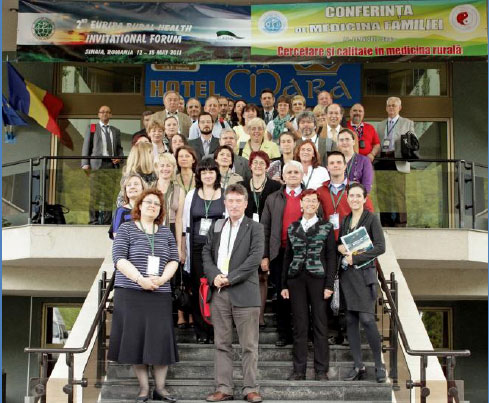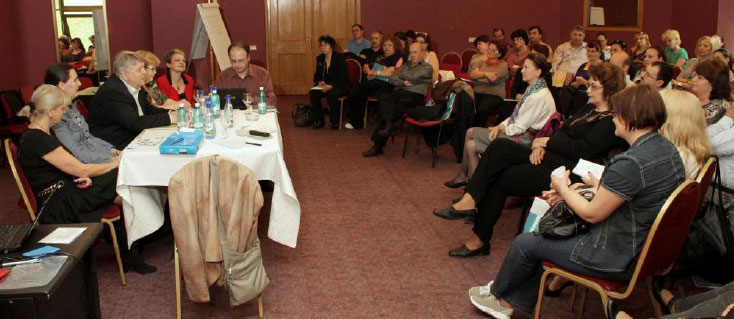From the President: The Uneven Climb - Part 1
WONCA's vision of a world where every family has a family doctor has always seemed like a huge mountain to climb. Experienced climbers expect some parts of a climb to be easy and other parts to be difficult. What makes parts easier or more difficult is usually the weather overhead or the terrain underfoot. Recent travels to Denmark, Romania, Spain, and Brazil revealed storm clouds over family medicine’s horizon and a changing political landscape that may trip up family medicine’s ascent. I hope that the clouds will pass with improvement of the global economy and that the shifting earth will settle. I fear however, that the thunder and tremors may signal important warnings about health care, and about us.
My next columns will describe these warnings in two parts.
In this issue of
WONCA News, I contrast in part one a country where family medicine has a long and strong tradition (Denmark) with a country where family medicine is struggling to gain traction (Romania). The next issue of WONCA News will include part two, in which I will discuss two nations where the national health care system has been re-built over the past two decades on a foundation of family medicine. In those countries, a fiscal crisis (Spain) and a change in government (Brazil) have threatened the continued climb of family medicine.
Copenhagen in April
April was classic Copenhagen. The weather shifted frequently from gray and rainy to bright and breezy. A railway warehouse converted into a hotel and sports facility was the venue of the annual meeting of EQuiP (European Association for Quality in General Practice/Family Medicine). Hosted by the Danish college of general practitioners (DSAM), the meeting was a wonderful opportunity to hear from European experts on quality in primary care, and to learn more about Danish health care.
Denmark has 5 million people and 12,000 physicians, slightly less than one third are family doctors. There are four medical schools producing 800-900 graduates annually, about 200 of whom enter five year GP post-graduate training programs. About three fourths of Danish GP trainees are female. Danish GPs own their practices – a usual group is 4-5 doctors, although about half are in a solo or single handed practice. A typical day involves 30-35 consultations. Payment to GPs has been a mix of capitation and fee-for-service.
A new contract with government went into effect on 1 April 2011, which will shift the capitation to fee-for-service ratio from 25:75 to 50:50. The Danes have invested heavily in primary care and reduced the number of hospital beds by about half over the past decade. Danish GPs have benefited from this shift in funding from hospital to primary Rich Roberts (center front) during the EQuIP banquet Frede Olesen delivering a lecture in Copenhagen WONCA News From the President August 2011 care, with average yearly salaries now around USD 200,000, or 10 per cent more than the average specialist.

Rich Roberts (center front) during the EQuIP banquet
 Frede Olesen delivering a lecture in Copenhagen
Frede Olesen delivering a lecture in Copenhagen
I spent a session with a GP as he saw patients in his practice. One consultation involved a middle aged woman with high blood pressure (210/115) who was stressed by family events and who was reluctant to take her prescribed medication. I listened with admiration as the GP gently negotiated a management plan she found acceptable. Even more important was his soothing style and his un-rushed approach, which encouraged her to share her worries about her family.
Patients, professionals, and politicians all seem generally happy with the Danish system. Yet, I caught a glimpse of some concerns. As more family doctors work fewer hours, there are concerns about continuity of care and a sufficient work force. Offsetting that trend is the tendency of more GPs to retire at age 62 or 63, rather than 60, now that their practice duties have lightened with no out of hours duties and their pensioner finances have been made less secure by the adverse global economy.
Communication and coordination with secondary care need improvement – the famed Danish electronic health record platform does not yet connect all parts of the health care system. About 15 years ago, hospitals began hiring GPs to improve communications between hospital and primary care, but this has not worked as well as hoped. An increased focus on measurement and improvement (registries track 30 disease conditions) comes at a time when government funding for GP quality units has been cut in half.
Bucharest in May
The climate in Romania was very different in May. The sun was warm and inviting. The Carpathian Mountains were spectacular. The European Association of Remote and Isolated Practitioners (Euripa) had come to Sinaia for its 2nd Rural Health Invitational Forum. I felt among kindred spirits as we discussed the joys and challenges of rural practice. Before Sinaia, I had several days in Bucharest meeting with medical students and family medicine trainees, and observing a family doctor at work.
 Euripa leadership at their conference in Sinaia, Romania. Prof John Wynn-Jones, president of Euripa, is center front
Euripa leadership at their conference in Sinaia, Romania. Prof John Wynn-Jones, president of Euripa, is center front
My afternoon in a Bucharest practice included a middle aged woman asking for disability papers to be completed for her adult daughter and a man with chronic abdominal pain. Paperwork and chronic pain are familiar to every family doctor working in any language.
Not only was the weather opposite between Denmark (unsettled) and Romania (fine), their health care systems were opposite. Danes benefit from a well resourced, primary care based, high performing system, while Romanians suffer under an under-resourced, specialist and hospital-centered, poor performing system. Spending less than any other European nation, Romania devotes 4.4% of its gross domestic product (GDP) to health care, about half that of Denmark.
Romania has about 21.5 million people, but is gradually losing population with a death rate that exceeds the birth rate and with losses to out-migration. Similarly, Romania produces fewer doctors than it loses to death, retirement, or emigration, especially to Belgium, France, and Italy. There are 12 medical schools, 2 in Bucharest, that graduate about 4800 doctors each year. Romania has about 48,000 physicians with about one in four being family doctors, all of whom must qualify by passing an examination.
From 1949 to 1989, Romania had a centralized state-run health system. But after the fall of Communism in 1989, major health system reforms began and a health insurance system was established. Up until three years ago, family doctors were managing fairly well. They owned their practices and were paid on a capitation basis. They were supplied with a laptop and printer. More recently, they are being pushed by the state run health insurance system to accept more fee-for-service (up to 50%), but they are limited to charging no more than one (1) Euro per consultation and they will not be paid for more than 400 consultations per month.
 Rich Roberts meets with Romanian family physicians to discuss their concerns
Rich Roberts meets with Romanian family physicians to discuss their concerns
Thus, Romanian family doctors appear caught in a system designed to make them fail. They must pay their own practice expenses (typically about 70% of their revenues and rising), while their fees are set by the government. The average Romanian family doctor earns about 600 Euro (about USD 860) per month after paying expenses. During my time in Bucharest, I tried to impress these concerns on to the Minister of Health. He had nice things to say about family medicine, but those supportive words have apparently not been translated into supportive action.
The two groups that represent family doctors (the scientific society and union) were locked in intense negotiations with the Health Insurance House much of the first half of 2011. I learned later that the negotiations had turned ugly, in June, as government officials reportedly used the media to mount personal attacks on the two women representing the two family doctor groups. Their courage and perseverance during those tense months were inspiring.
Contrasts
The contrast between the Danish and Romanian health care systems was shocking. Danish family doctors are viewed as the hub of their system and have significant power and resources. Romanian family physicians are marginalized and have too few resources. Yet, I was impressed by the similar problems their patients brought and by the dedication shown by the family doctors of both countries.
I will conclude part two with lessons learned and with some suggested strategies for family doctors and their colleges.
Until then, to my Danish friends: Tak for your gracious hospitality and for the success of the Danish primary care system, which stands high up the mountain as a vision for us all.
To my Romanian friends: Mulţumesc for your many kindnesses during my stay, for your continuing the climb up a very difficult slope, and for having the courage to shout out the story of family medicine when others have tried to silence you.
Richard Roberts
... continued in the October issue of WONCA News.